From The CRPG Addict
ORIGIN Systems (developer and publisher)
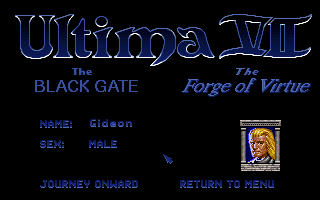 |
| This may be the first CRPG with an expansion pack that takes place within the main quest. |
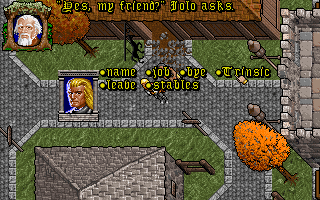 |
| I still find everything about this screen annoying. |
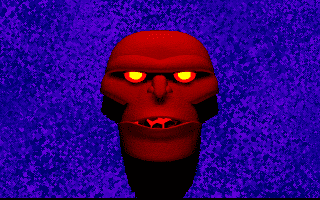 |
| The first appearance of the Guardian. |
Avatar! Know that Britannia has entered into a new age of enlightenment. Know that the time has finally come for the one true Lord of Britannia to take his place at the head of his people. Under my guidance, Britannia will flourish, and all the people shall rejoice and pay homage to their new Guardian! Know that you, too, shall knell before me, Avatar. You, too, shall soon acknowledge my authority, for I shall be your companion, your provider, and your master!
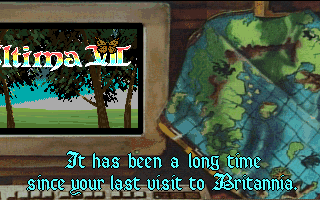 |
| I can’t not think about it. How is my character playing Ultima VII? Does he have his own character? How far down does it go? |
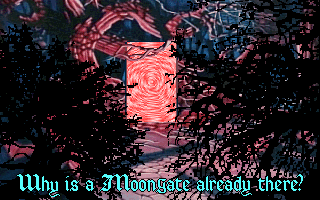 |
| I’m not sure this ever gets answered. |
The manual is called The Book of Fellowship, and it describes the history, geography, and society of Britannia in the context of the growth of a quasi-religious/philosophical order called the Fellowship. Jimmy Maher has a particularly excellent article examining the parallels between the Fellowship and the Church of Scientology. (Garriott had apparently read a 1991 Time magazine exposé of the Church while the game was in its planning phase.) But I also see a lot of the (then-) growing “prosperity gospel” in the Fellowship, and Batlin strikes me as much of a Joel Osteen (although no one at ORIGIN would have been aware of him in 1992) as an L. Ron Hubbard. One particular analogue with prosperity theology (and not Scientology) is the organization’s “layered” approach to scripture. The Fellowship does not reject the Eight Virtues of the Avatar any more than prosperity theology rejects the Bible. It simply adds its own new layer of interpretation (simplification) on top of them, encouraging its followers to hold true to the past without really focusing on it. The emphasis is all on the new material–in the case of the Fellowship, their Triad of Inner Strength.
The manual begins with Batlin of Britain’s introduction of himself. He presents himself with false humility as just a regular man, a fellow “traveller” through life, who has happened to stumble upon a bit of wisdom that he wants to share. Throughout his biography, he brags-without-bragging that he has served in all eight of the classical Ultima roles: Born and raised by druids in Yew, a first career as a fighter in Jhelom, then as a bard in Britain; trained by a mage from Moonglow; serving for a while among a company of paladins in Trinsic and as a tinker in Minoc; and finally spending a sojourn with the rangers of Skara Brae before ending up as a humble shepherd in New Magincia. His series of portraits through these sessions show a square-jawed, hale, charismatic figure, and it’s no surprise when we actually meet him in-game to find a fatter, oilier version than is presented in the official portraits.
 |
| What kind of pretentious jackass divides his own biography into sections called “part the first” and “part the second”? |
During his description of overcoming some wounds in Minoc, Batlin says:
A healer there told me that without the proper treatments (for which he charged outrageous prices) I would most probably die! I angrily sent him away. After a time I did mend. I had learned that the healing process takes place mostly in one’s mind and have since placed no trust in healers who greedily prey upon the afflicted.
Here is our first actual contradiction with the world as we’ve come to know it as an Avatar. It manages to parallel Scientology’s rejection of traditional psychology, sure, but also the Christian Science rejection of traditional medicine and perhaps “New Age” medicine in general.
He describes in his history how he met his two co-founders of the Fellowship, Elizabeth and Abraham (the “E.A.” being an intended swipe at Electronic Arts, which would have the last laugh by purchasing ORIGIN the same year), and how his experiences led him to develop the Triad of Inner Strength. If the casual reader is not yet convinced of Batlin’s villainy, it should become apparent in the section where he discusses the “ratification” of the Fellowship by Lord British. Though calling him “wise” and paying him obsequious homage, Batlin manages to paint the king as a capricious, dismissive sovereign, uninterested in the Fellowship until Batlin managed to “prove” himself with a display of confidence that manages to reflect the Fellowship’s own philosophies. The section brilliantly manages to associate Batlin with the king and the king’s favor (for those who still admire the king) while also planting a seed of doubt about Lord British’s fitness to rule.
What he does to the Avatar is less subtle but far more damaging. Batlin knows that if his Fellowship is going to replace the Eight Virtues as Britannia’s predominant theology, and if he himself is going to replace the Avatar as the spiritual figurehead, he must undo the Avatar. But the memory of the Avatar is too popular, his friends too influential, for Batlin to use a direct attack. Thus, he snipes and undermines and saps from all angles while pretending to admire the Avatar himself. “The Fellowship fully supports the Eight Virtues of the Avatar,” he says, but that “it is impossible to perfectly live up to them. Even the Avatar was unable to do so continuously and consistently.” Thus pretending to support the Eight Virtues while rejecting them, he introduces the Fellowship’s Triad of Inner Strength:
- Strive for Unity: Work together to achieve common goals.
- Trust Thy Brother: Don’t live your life full of suspicion and doubt.
- Worthiness Precedes Reward: Do good for its own sake before expecting compensation.
Maher’s article points out how these three principles are not only kindergarten-level theology, but how easy it is to twist them towards evil ends. “Work together, don’t question, don’t ask anything in return” could be the motto of a fascist organization as easily as a charitable one.
Most of the slights against the Avatar occur during the second half of the manual, ominously titled “A Reinterpretation of the History of Britannia.” Batlin walks through the events of Ultima I through VI much as the previous game manuals did, but with the occasional anti-Avatar salvo disguised as support. For instance, after describing the events of Ultima II, he says:
While there have been speculations as to the motivations of the Avatar, there is insufficient evidence to show that the Avatar was driven to violence by jealously over Mondain’s romantic involvement with Minax. That being said, such theories are hereby denounced and should not be given consideration.
Soon afterwards, he “formally disagrees” with “those who say the Avatar should have handled [the events of Exodus] differently.” He casts aspersions–no, sorry, alludes to other people casting aspersions–on the Avatar’s motives in the Quest of the Avatar. As for Ultima VI: “Those who say that this terrible and destructive war could have been prevented had the Avatar not appropriated the Codex from its true owners are merely dissidents who are grossly misinformed.” Leaving aside the fact that the Avatar wasn’t the one who took the Codex, Batlin commits here the slimy politician’s trick of introducing a slur while simultaneously denying it, thus seeding doubt while trying to remain above it. I’ve learned the hard way to at least try to keep politics out of my blog, but it’s literally impossible not to think of Donald (“many people are saying”) Trump when reviewing this aspect of the Batlin character or indeed the Batlin character as a whole. If I didn’t say it here, someone would have filled in the blank in the comments as they did in the Maher article.
Aside from the undermining of the Eight Virtues, Lord British, and the Avatar, the manual is notable for numerous asides that make the veteran player eager to jump in and start swinging his sword. In his description of his time as a fighter, Batlin talks about “unruly lords wag[ing] war against each other . . . over Lord British’s objections.” Clearly, peace has broken down, but why? We later hear that Skara Brae is for some reason a “desolate ruin” (remind me to come back to another Batlin quote when I actually visit Skara Brae). Lock Lake near the city of Cove has become polluted. The town of Paws is said to be languishing in poverty. Some mysterious figure called the “Sultan of Spektran” has set up his own government on the island previously occupied by Sutek. The gargoyles have their own city, called Terfin, but there’s a suggestion that local mines might be exploiting them for labor. Runic writing has fallen out of favor. There have been recent droughts. And worst of all, magic has been breaking down and its practitioners going insane.
Perhaps the biggest shock is that it has been 200 years since the Avatar last visited Britannia. This is presumably since his last visit in Ultima VI, not Ultima Underworld. The manual makes no acknowledgement at all of the events of Underworld; no mention is made of a colony on the Isle of the Avatar, nor its destruction in a volcanic eruption.
Ultima IV: Quest of the Avatar still has the best quest of the series, in my opinion, but Ultima VII may have the best plot. This isn’t the first time that a CRPG has featured writing and plotting worthy of a novel (I would probably give that award to Starflight), but it’s still rare in the era. I understand that we owe this depth of narrative to lead writer Raymond Benson, who would later go on to take over the James Bond novel series. Benson was a playwright and composer who had previously worked on computer adaptations of Stephen King’s The Mist (1985) and the James Bond games A View to a Kill (1985) and Goldfinger (1985). He was recruited by ORIGIN in 1991 and wrote some dialogue for Martian Dreams before beginning Ultima VII.
Someone like Benson was exactly what ORIGIN needed. The company may have “created worlds,” but they always did so in a way that was both a little sloppy and a little too tidy, with poor respect for their own canon. I have discussed at length my disappointment over the way the game treated the concept of “the Avatar” after Ultima IV. Well, here, in the opening documentation of Ultima VII, we have an in-game character who personifies that lack of respect, who manages to take the confusion over ORIGIN’s retcons–was the Avatar really the same hero who defeated Mondain?–and twist it to his own ends. When I finished the manual in 1999, I was never more eager to leap into a world and start putting things right. I am only slightly less eager now.
Note: To avoid loading transitions and other throwbacks to an earlier age, the developers of Ultima VII changed the way DOS allocates memory. Their solution required players to boot from a special disk. I remember that this created all kinds of problems when I originally tried to play the game in the late 1990s. Also, processors had gotten so much faster that the characters moved at lightning speed, and I had to use a special program called Mo’Slo to slow things down. I don’t think I ever got the sound working properly back then. The emulation era and the folks at GOG sure make this much easier.
Original URL: http://crpgaddict.blogspot.com/2020/03/game-363-ultima-vii-black-gate.html

